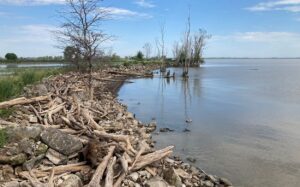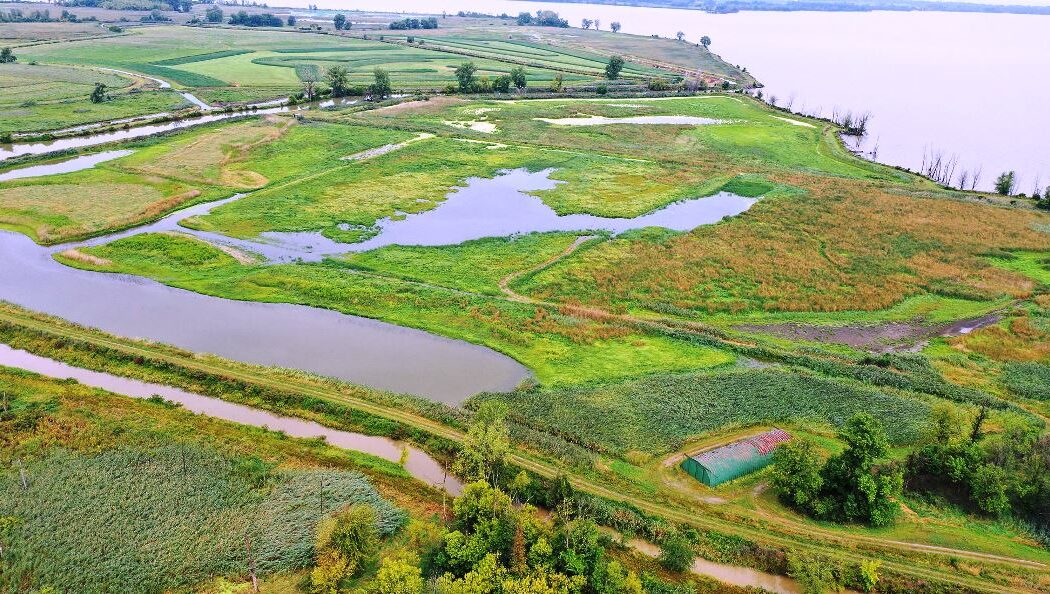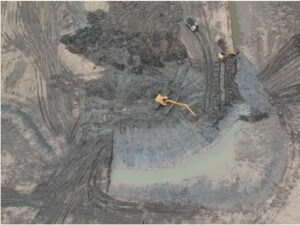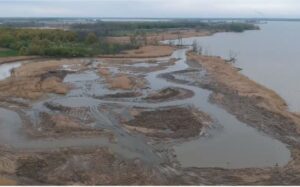Not far from where the waters of Ohio‘s Sandusky Bay meet the shore, large yellow bulldozers sound their back-up alarms as they rumble across the muddy ground. Backhoes dig up and shift soil, recontouring the land. At first glance, it looks like any other construction site, as soil is dug up and shifted around.
But this isn’t construction—this is large scale habitat restoration. And to understand why it’s happening we need to go back a few hundred years.
An Interconnected and Thriving Past
Located where the mouth of the Sandusky River connects to the waters of Lake Erie, Sandusky Bay is one of the most important bodies of water in northern Ohio with one of the largest ranges of coastal wetlands in the Lake Erie basin.
Before European colonization, it was a thriving, interconnected wetland matrix home to diverse wildlife and native vegetation. Fish, such as northern pike, used the shallow wetlands as nursery and spawning grounds, with vegetation providing shelter and plenty of food for young, newly hatched fish, such as insects and small crustaceans.
In the spring and fall, a cacophony of birdsong sounded from the shorelines, as migratory songbirds and waterfowl stopped at the waters and marshes to rest and refuel on their journeys. Indigenous Peoples fished the healthy, productive waters and foraged the plants growing throughout the open bay.
In fact, the Sandusky Bay was part of the Great Black Swamp—a deeply interconnected network of wetlands, waterways, dense forests and grasslands that stretched to northeast Indiana.
But, in the 19th century, European settlers began to drain and transform the Great Black Swamp into rich and productive agricultural land which had lasting, unintended consequences for the health of Lake Erie.
Wildlife Needs Wetlands
Wetlands and the coastal areas around Sandusky Bay once supported diverse wildlife and native plants.
While the isolated wetlands around Sandusky Bay today still support migratory birds and other wildlife, their populations have greatly declined due to the fragmented state of the land around the Bay.
The Bay Today
Today, Sandusky Bay looks far different from those earlier times, altered significantly by the dense population, various industries and agriculture in its surrounding areas.
As the land was settled and developed, the Bay’s waterways were rerouted and its wetlands separated from each other. Shorelines are now hardened by earthen and rock dikes, disrupting the Bay’s ecosystem.
Instead of waves dissipating on shore, the dikes ricochet the wave energy back into the Bay and churn up sediment making the waters turbid and preventing growth of native vegetation.
All of these factors together exacerbate the annual harmful algal blooms that erupt throughout the Western Lake Erie Basin during the warmer months.
Thanks to the channelized and straightened waterways and isolated wetlands, fertilizers and sediments from lands upstream flow into the Sandusky Bay before they can be naturally filtered, creating the perfect conditions for algae growth.
These landscape changes have also reduced suitable habitats for all kinds of wildlife, but especially for migratory and shore birds. While this area is still a birding hotspot, the abundance and diversity of migratory and shorebirds that once thrived here have declined as their habitat is now reduced to small, isolated wetlands.
Restoration at Scale
As part of the H2Ohio Initiative, The Nature Conservancy (TNC) in Ohio is collaborating with a diversity of stakeholders on a vision to restore and enhance ecosystem function and habitat in Sandusky Bay.
The first part of this ambitious plan—the Pickerel Creek Riparian project—was completed in 2023, reconnecting the creek to its floodplain and restoring more than 50 acres of wetland habitat.
The newly enhanced, connected wetlands will allow for more natural movement of water between the creek and land during storms.
The reconnected floodplain and restored wetlands will also allow sediment and nutrients to settle out before reaching Sandusky Bay, improving water quality and reducing harmful algal blooms in the Bay during the summer.
Now in the next phase of this restoration, TNC and partners are planting diverse native wetland vegetation, which will increase fish and wildlife habitat. Monitoring and removal of invasive species will take place over the coming years to ensure that the native plants successfully establish.
Our work at Sandusky Bay is a testament to TNC’s ability to advance large, innovative projects, from beginning to implementation.
Following the completion of the Pickerel Creek Riparian project, work will begin on the second project within the Pickerel Creek Wildlife Area near Raccoon Creek. As part of this work, TNC will restore more than four acres of coastal wetlands and plant native aquatic vegetation.
“Our work at Sandusky Bay is a testament to TNC’s ability to advance large, innovative projects, from beginning to implementation,” says TNC Restoration Ecologist Ashlee Decker.
“Our work began with our staff’s comprehensive work in the legislature advocating to establish the H2Ohio fund set up and following that all the way through to implementing actual restoration work on the ground and following that work into the future to ensure it succeeds,” she added.
Modeling Future Restoration
The Pickerel Creek Riparian Project and the Raccoon Creek Project are part of a larger landscape-scale restoration vision through the Sandusky Bay Initiative, which aims to restore more than 1,000 acres of habitat and associated ecological function to the entire 40,000-acre Sandusky Bay.
There are more than a dozen projects being planned over the next decade, with numerous partners and stakeholders, such as the Ohio Department of Natural Resources and the Ohio Division of Wildlife, working together to achieve this conservation vision.
TNC is a major player in this initiative, leading the way in planning, design and managing funds to accomplish the work.
Restoring Landscapes

The Raccoon Creek project will create dynamic, nature-based shorelines to diminish wave energy, restore wetlands and protect eroding shoreline infrastructure. © Alexis Sakas/TNC
The Sandusky Bay Initiative, which TNC is a major partner, aims to restore more than 1,000 acres of habitat and associate ecological function to the entire Sandusky Bay area. More than dozen projects are in progress or being planned, including the Pickerel Creek Riparian project and the Raccoon Creek project, which TNC is leading.
“It’s a complex system, which requires a lot of science to inform restoration,” says TNC Natural Infrastructure Director Alexis Sakas.
“Strategically restoring natural infrastructure is novel work for TNC in the Midwest and for Lake Erie. We can’t put things back to exactly the way they were, but we can create more habitat and improve Sandusky Bay for nature and people,” she concluded.
What’s more, this work contributes directly to TNC’s 2030 goals for conserving rivers and protecting people from climate change.
Making Sandusky Bay more resilient through restoration and nature-based solutions has cascading effects on the broader Lake Erie and Great Lakes systems, ultimately helping create places where people and nature thrive.
Unless otherwise credited, all photos are courtesy of TNC.
This article originally appeared on the TNC website. Reprinted here (with minor edits) by permission.




